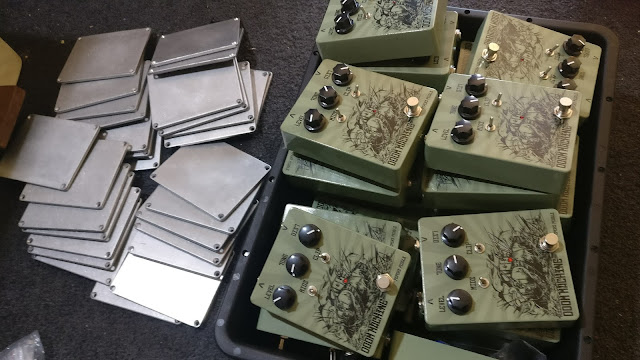UPDATED 16-2-2018 - Drilling templates, EQ mods, Diode Mods
After many hours of perfecting and careful component selection and measuring of various crucial components I have finally finished my HM-2 Clone PCB.
I have aptly named it HM-Too Many Clones and it's a very very close recreation of the MIT and HM-300 I have here at home.
This PCB is available to everyone!! You can buy it straight from the fab shop in minimum quantities of 10.
Comes in 2 different versions Pots Up and Pots Down. The PCB itself comes with mods and 3PDT daughter boards too. So it's very flexible. Make sure you choose the right colour. I think it defaults to RED (they do look awesome in red).
BUY THE PCB AT DIRTYPCBS.COM
HM-Too Many Clones Build Documentation
First of all the PCBS will come as a panel with all the elements connected together and if you have ordered from the above link you will get a minimum of 10x PCBS you may be lucky and get a few more, that's the beauty of the protopack. These smaller PCBS are joint together by something called a "mouse bite" a row of small holes. All these panels can be easily snapped apart to make the HM-TMC (Too Many Clones) into a few different versions.HM-2 classic 4 knob
HM-2 with Mids control 5 knob
HM-2 with Mids and Blend control 6 knob
FX-56B Classic 4 knob verison
FX-56B with Mids control 5 knob
FX-56B with Mids and Blend control 6 knob
For more information on my 3PDT daughter boards have a look here. the 1N5817 can be installed either on the 3PDT board OR on the main board. Jumper the one that isn't used.
Now I guess we better go over the BOM. This is the BOM for the one that is in the used in the demo recording below. All component values are marked on the PCB. Values marked with an "*" are the components needed to exchange for the DOD FX-56B HM-2 clone and some are for other mods to come.
You don't necessarily need to use the components I have stated above that was my BOM for the build used in the recording. You are welcome to experiment with ICs transistors, diodes and cap types (be wary of tolerances on caps). There is no reason why you can't use TL072 Op-amps, LEDs for diodes and BC series transistors. I have found the FET buffer can be a J201, 2N5457 or 2SK30 (crossed legs) and all get basically the same sound. You can use 2n3904 and 2n3906 for the transistors too. I've found that the PNP transistor ideal hFE range is about 280-320, the NPN ideal hFE range is about 350-420. Once again experimentation is welcomed.
Wiring configuration for the 5 or 6 knob verison. If you want either just Blend or just Mids mods simply snap off the PCB you don't want and rearrange the wiring to suit.
Wiring configuration for the classic 4 knob HM-2 clone. DON'T FORGET TO BRIDGE THE SOLDER PAD
DOD FX-56B Mods
These are all the component changes required to change it from an HM-2 to a FX-56B
Clipping Diode Mods
By using a DPDT switch (ON-ON or even ON-OFF-ON) and different clipping diodes different flavours of distortion can be obtained. This is a drawing showing where to connect wires to the PCB to take off to switches to add clipping options.Any combination of diodes or transistors can be used. It's totally up to you to experiment.
Gyrator EQ Adjustments
Have a little play with the EQ bands.
Download my Gyrator EQ calculation spreadsheet HERE
The spreadsheet has all the HM-2 values already inputted.
Drilling Template
I have made up a drilling template to help with assembling this pedal into a box. The file is a .svg which is a scalable vector file. I use Inkscape to make these drawing and I recommend it is used to open this file. Inkscape can be found HERE.
I have set this up using layers so you just need to turn layers off or on as you need them
The template include all the versions and ideal setup
Download the drilling template HERE
Finished product
This is my completed build on PCB version 1.0. The new PCBs are a little bit better organised and have a few errors corrected on them.
This is what you want to hear. Results! This is my HM-2 clone played by my great friend Josh Hughes. He has absolutely blown me away with this demo clip. No video just recorded audio.
This is the setup he used for recording all the tracks on guitar and bass in the above demo.
The signal goes Guitar -> NS-2 Loop Send- > HM-TMC -> MXR Fullbore metal -> NS-2 Loop Return -> 35W Pepers Pedals mini power amp. The pedals were used at the settings below. The Fullbore metal is used to simulate a slightly dirty amp channel and for some tone shaping. After talking with him the NS-2 is only to remove noise for recording purposes. The pedal is "as quiet as a mouse"
Any comments or questions on this build put them down below. I will constantly update this page with more mods and additional build instructions if they are needed.
Looking forward to seeing all the community builds come out!!

























































